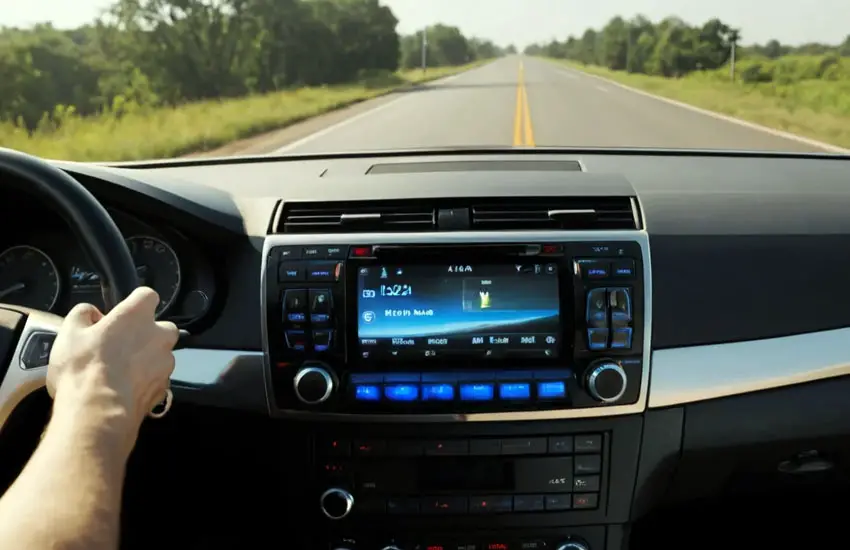As an Amazon Associate, I earn from qualifying purchases at no extra cost to you.
Car Stereo Has Power But No Sound From Speakers: Easy Fixing Guide
Have you ever turned on your car stereo, only to find that the display is working, the power is on, but there's no sound coming from the speakers? If so, you’re not alone. Many drivers face this frustrating issue where the car stereo seems to be working fine, yet there is no audio output. Understanding why this happens and how to fix it can save you time and money, especially when you can handle the problem on your own. In this blog post, we'll explore the possible causes of no sound in your car’s stereo system and provide practical solutions to get your speakers working again.
Why Your Car Stereo Has Power but No Sound from Speakers
The issue of a car stereo having power but no sound from the speakers can be caused by various factors. It could be a problem with the wiring, settings, or a malfunction in the stereo system itself. Below, we’ll explore the main reasons why this might happen and how you can troubleshoot them to get your stereo back in working order.
1. Disconnected or Loose Wiring
One of the most common reasons your car stereo has power but no sound from the speakers is disconnected or loose wiring. The wiring is responsible for sending audio signals from the stereo to the speakers. If there is a loose connection or a wire that has come undone, the audio signal may not reach the speakers. This can happen if the wiring is old, damaged, or improperly installed.
How to Check for Loose or Disconnected Wires
- Turn off the power: Before inspecting any wiring, make sure to turn off your car stereo and disconnect the battery to avoid any electrical issues.
- Check the speaker connections: Examine the speaker wires that connect the stereo to the speakers. Look for any loose or disconnected wires. Ensure that all the connections are firmly in place.
- Inspect the head unit wiring: The stereo's wiring harness might have come loose or disconnected from the main unit. Make sure the connection is secure.
- Look for visible damage: Check for any frayed or damaged wires that may need to be replaced. If you find any, they will need to be repaired or replaced.
If you’re not confident about checking the wiring yourself, it’s always a good idea to take your car to a professional to avoid damaging the system further.
2. Blown Fuse
Another reason you might be experiencing no sound from the speakers is a blown fuse in the stereo system. Fuses are designed to protect electrical circuits from power surges and other electrical issues. If the fuse is blown, the power may still be reaching the stereo, but the speakers won't receive any audio signal.
How to Check and Replace a Blown Fuse
- Locate the fuse box: Your car stereo should have a fuse located either in the stereo unit itself or in the car’s fuse box. Consult your car's manual to find the exact location of the fuse.
- Inspect the fuse: Once you find the fuse, remove it and check to see if it’s blown. A blown fuse will typically have a broken or blackened metal strip inside.
- Replace the fuse: If the fuse is indeed blown, replace it with a new one of the same amperage. Make sure the new fuse fits properly to avoid further issues.
A blown fuse is a relatively simple fix, and once replaced, your stereo should begin producing sound again.
3. Faulty or Incorrect Stereo Settings
Sometimes, the issue might not be with the wiring or hardware, but rather with the settings on your stereo itself. It’s possible that the volume is set too low, the mute function is turned on, or the wrong audio source is selected.
How to Check Stereo Settings
- Check the volume: Make sure the volume is turned up. It may sound simple, but it's easy to forget that the volume is set too low, especially if the stereo’s display is showing that it’s on.
- Verify the audio source: Make sure you have selected the correct audio input. If your stereo is set to AUX or Bluetooth mode but your phone or other device isn't connected, you may hear no sound. Switch to the radio or CD mode and see if the issue persists.
- Look for the mute button: Many car stereos come with a mute function. Ensure the mute button is not engaged. If it is, turn it off to allow the sound to come through.
- Check balance and fade settings: Some stereos have balance and fade settings that control the distribution of sound between speakers. If these settings are incorrectly adjusted, it might cause no sound from certain speakers. Reset these settings to default and see if the sound returns.
If adjusting the settings doesn’t work, it may be worth checking if there’s an issue with the stereo’s software or hardware.
4. Faulty Car Stereo Unit
If your stereo system is still not producing sound after checking the wiring, fuses, and settings, the issue could lie within the stereo unit itself. Car stereos are complex devices with various internal components that can fail due to wear and tear, power surges, or manufacturing defects.
How to Diagnose a Faulty Stereo Unit
- Test with a different stereo: If you have access to a similar stereo, try swapping out the current unit with a working one. If the new stereo works, then it's likely that your original unit is faulty.
- Check for overheating: Sometimes a stereo unit may overheat and stop working properly. If your stereo feels unusually hot, let it cool down and then try turning it on again.
- Seek professional help: If you suspect that the stereo unit is the problem, it’s best to have it professionally checked. A technician can test the internal components and determine if repairs or replacement are needed.
5. Broken Speakers
Finally, the problem could be with the speakers themselves. Over time, speakers can wear out, develop issues with their wiring, or even become damaged beyond repair. If your speakers are broken, no sound will be emitted, regardless of whether the stereo has power.
How to Check for Broken Speakers
- Test the speakers: To determine if the speakers are the issue, you can test them by connecting them to a different working stereo. If they don't produce sound on the new stereo, it’s likely the speakers themselves are faulty.
- Inspect the speaker wiring: Even if the speakers seem fine, check the wiring that connects them to the stereo. If there's a loose or frayed wire, that could prevent sound from being transmitted.
- Listen for distortion: If the speakers are producing sound but it's distorted, the speakers might be damaged. In this case, replacing the speakers would be the best solution.

How to Prevent Future Issues with Your Car Stereo
Now that we've discussed the common causes and solutions for why your car stereo might have power but no sound, let's go over a few tips to prevent similar problems in the future.
1. Regularly Inspect and Maintain Your Stereo System
One of the best ways to keep your car stereo in good working condition is to regularly inspect it. Check for any loose wires, frayed connections, or damaged components that could cause problems down the line. Keeping the system clean and well-maintained will help extend its life.
2. Avoid Overloading the System
Be mindful of how much power you're putting through your stereo system. Avoid overloading it with speakers or amplifiers that it wasn't designed to handle. Overloading can cause damage to both the stereo and the speakers, leading to potential issues in the future.
3. Use Quality Equipment
When upgrading or replacing components like speakers or wiring, make sure you use high-quality, compatible parts. Poor-quality equipment can cause issues like poor sound performance, frequent malfunctions, or complete failure of your stereo system.
4. Protect the System from Power Surges
Car stereos are vulnerable to power surges, especially if you're driving in areas with unstable electricity or during storms. Consider using a surge protector to protect your stereo system from electrical damage.
I hope this guide helps you understand the possible reasons why your car stereo has power but no sound. With the information provided, you can troubleshoot the issue and possibly fix it on your own. However, if the problem persists, don't hesitate to consult a professional to get your stereo back to working order.
Are These Questions in Your Mind?
Is it possible to fix a car stereo that has power but no sound myself?
Yes, in most cases, you can fix a car stereo with no sound by checking the wiring, replacing the fuse, or adjusting the settings.
Can a blown fuse cause a car stereo to lose sound?
Yes, a blown fuse can prevent the stereo from sending audio signals to the speakers, resulting in no sound.
Do I need to replace my stereo if it’s not making sound?
Not necessarily. Before replacing the stereo, check the wiring, fuses, and settings to see if those are causing the issue.
Can a speaker be faulty even if it looks fine?
Yes, speakers can be damaged internally without visible signs, such as a broken coil or deteriorated components.
Is it safe to handle car stereo wiring myself?
If you’re confident in your skills and have the proper tools, it's safe to handle the wiring. However, if you’re unsure, it's best to seek professional help.
Can bad speakers cause issues with the entire stereo system?
No, bad speakers usually only affect the sound output, but they won't stop the stereo from working altogether.
Is there a way to test if my stereo is the problem?
Yes, swapping out the stereo with a working one can help determine if the original stereo is the issue.
Can overheating cause the car stereo to stop working?
Yes, overheating can cause a car stereo to malfunction. If your stereo gets too hot, let it cool down before using it again.
Do I need to replace my car stereo if it’s not producing sound?
Not always. Before replacing it, check for issues like wiring or fuse problems, which are often easier and cheaper to fix.
Can I install a car stereo myself if it stops working?
If you have basic knowledge of car electronics and follow safety precautions, you can install or replace the stereo yourself. Otherwise, professional installation may be a safer option.











